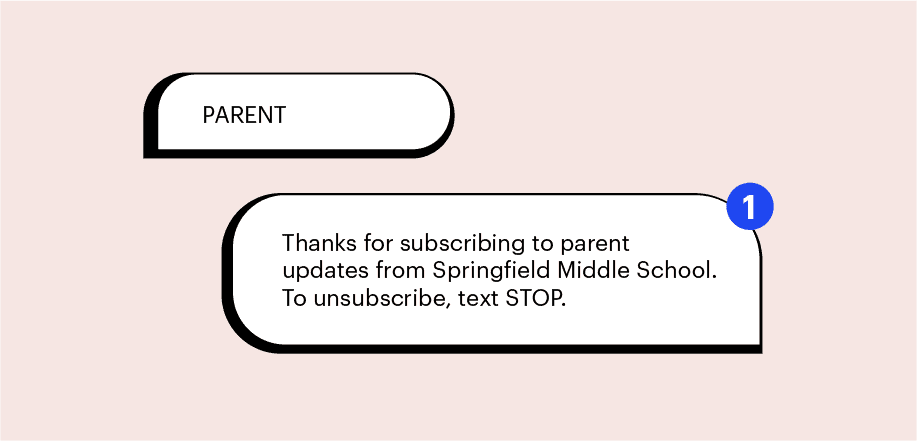Mass text messaging for schools offers an incredibly convenient way for administrators to quickly share crucial information with the entire student body, staff, and parents. Schools of all levels can use it. With elementary and middle schools, mass texting will likely focus primarily on parents and staff. High schools may also mass text students, and colleges will focus on students and staff.
Using SMS for schools is especially helpful in emergencies or for spreading information about school closures due to weather. Explore how you can use an SMS alert system for schools and the best methods in more detail.
What is mass text messaging?
The term mass text messaging means exactly what it sounds like: sending text messages in mass. This is a form of automated messaging that lets you send identical messages to hundreds or thousands of people at once.
Mass texting contrasts with group texting due to the number of people who receive the message. Additionally, group texting typically lets all recipients see the numbers of the other recipients; mass texting does not.
Why do people prefer texting?
Before you set up your school texting service, you may want some reassurance that students, parents, teachers, and staff will appreciate it. You should not overthink this, as texting is incredibly popular.
Consider that texts have a 98% open rate and that 90% of people prefer talking to companies or schools over text instead of over the phone.
There are several reasons for the popularity of texting, including the following benefits of text messaging.
- It is time-efficient. People appreciate the way that text messages let them make the most of their time. They don’t have to interrupt their current task to look at the message immediately, which they would have to do to answer a phone call. Additionally, they can quickly glance at a text in seconds while completing another task. As a bonus, it is also time-efficient for you, especially when you use a standard message and a text messaging service.
- No one has to wait on hold. Using traditional methods of communication, like phone calls, means that the caller has to wait for the answerer to pick up and may have to wait on hold. This isn’t an issue with texting, as the recipient will respond in their own time.
- It is instant. Texting delivers the message right away, which is especially important in emergencies. After all, recipients want to know that they will receive time-sensitive information promptly.
- You can easily ask quick questions. SMS also makes it easy to ask quick questions that don’t necessarily require a phone conversation. For example, a student can text to see if there is a snow day.
- It is private. Texting also offers more privacy than talking on the phone. There is no worry about someone overhearing your conversation; they would have to look directly at your phone to do so.
- It is less disruptive. Sending and receiving texts is also much less disruptive. As mentioned, you can view a text while doing something else. You can also send or receive them even if you are somewhere that you need to be quiet.
- There are no awkward silences. Some people simply find sending text messages less stressful than calling because of the lack of awkward silences that can happen on the phone. Others like the fact that you can plan your message and take your time.
- People keep their phones close. There is also the fact that people tend to keep their phones close to them. 85% of people keep their mobile phones within arm’s length, and 61% feel uncomfortable when their phones aren’t nearby.
How does mass text messaging work for schools?
There are many situations when text messaging for schools comes in handy. While we already touched on some of them, the following goes into more detail and offers examples of each of the types of text messaging campaigns.
Remember that the following are just some examples of situations when you can use bulk SMS for your school. You can also encourage coaches, teachers, and club leaders to use texting to communicate with their respective students.
Informing about closings/cancellations
Closings and cancellations are among the most popular use cases of text messaging systems for schools. This can include weather-related closures and cancellations, such as a snow day causing all extracurriculars to be canceled or leading to canceled classes. It can also be related to other things, such as canceled classes due to a different event on campus or health concerns.

U of A Bulls, due to extreme snowfall, classes and school-sponsored events will not be held today, 01/24. Stay safe out there!
Issuing emergency notifications
When it comes to emergency alerts and notifications, an SMS alert system for schools will usually be one of the best options. The high open rate and the fact that most people see the messages quickly make this the ideal communication for time-sensitive information.
Emergencies can include sending tornado warnings to students, letting them know about fires, or informing them about the need to evacuate or go into lockdown.

Emergency alert: Due to an electrical fire, the Tanner Building will be evacuated and closed until further notice. Please avoid the building and surrounding areas.
Giving event reminders
Schools can also use mass texts to remind people about events. Maybe the administration wants to remind teachers about an upcoming training day or students about an all-school assembly. Or perhaps the mass texting for schools will remind parents about upcoming parent-teacher conferences.

Dear Hollow Elementary School parents, this is a reminder that parent-teacher conferences will be held next Wednesday and Thursday from 6:30-8:30 pm. Please sign up for a time at pdm.com/signups
Informing the student body
Along with some of the previous examples, using mass text to inform the student body can include informing students about events, cancelations, or emergencies. Or administrators can use texts to inform students about important deadlines for paperwork or payments.
You can even apply the idea of informing the student body to something like SMS marketing. For example, if you sell school apparel, you could announce sales on various items over texts.

Happy game day! 🏈 To celebrate the Homecoming game, all sports apparel will be 15% off. Use your student ID in-store or online at pdm.com/homecoming
Connecting with faculty
As mentioned, a school texting service can also help the administration connect with the staff for emergency announcements, schedule changes, training announcements, and more. You can even use texting to make it easy for faculty to communicate with each other or ask questions, as in the following example.

Happy Faculty Appreciation Day! All teachers, faculty, and staff are welcome to help themselves to the donuts in the teacher’s lounge.
Connecting with parents
Texting can also keep the parents informed and connected, overlapping with many of the above uses. You can even offer parents the ability to text your school with quick questions or concerns or schedule an appointment with a teacher or administration member. Texting teachers’ phone numbers may even replace some parent-teacher meetings.

Parent
Thanks for subscribing to parent updates from Springfield Middle School. To unsubscribe, text STOP.
The Clery Act for Schools and SMS messaging
The Clery Act is one of the many uses for mass texting in schools, thanks to its requirement that schools inform students about specific incidents. As a refresher, the Clery Act is a statute at the federal level that applies to all universities and colleges that use federal financial aid programs.
Specifically, the Act requires them to give people on campus a timely warning following any crimes that could pose a threat to employees or students. Mass text messaging for schools is the simplest method of following the Clery Act.
A word on compliance for SMS marketing
Before you get too far along in planning your mass texting, make sure to consider compliance. The most important thing to consider is the CAN-SPAM Act. This Act applies to emails and text messages from businesses and organizations. While it is designed for SMS marketing, it also applies to messages from schools.
The most important part of it for schools to pay attention to is the fact that recipients must opt-in. You need to have confirmation from them that they have signed up to receive text messages. Opting in can be as simple as checking a box on a form when they provide their cellphone number, but you cannot use a pre-checked box. You can also use a keyword campaign to gain subscribers and consent or rely on web forms.
Other best practices to follow to remain compliant include:
- Identify yourself as the sender of the message.
- Make it easy to opt out of the messages.
How do I choose the best school text service?
Setting up SMS for schools offers the most straightforward and most convenient method of reaching the entire student body, parents, or your teachers and staff. It is especially important in emergencies and to announce school closures. But you can also use it for other important announcements.
The best mass text messaging for schools will let you remain compliant with the CAN-SPAM Act and allow you to send mass texts easily. Podium, for example, offers the ability to send mass texts and engage in text-based conversations. This gives you the freedom to let students and parents reach out to you over text with any questions or concerns. This type of best system will also have a range of small business messaging tools. Those tools can handle everything your school will need to manage your texts.



